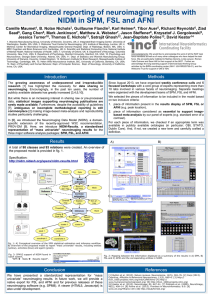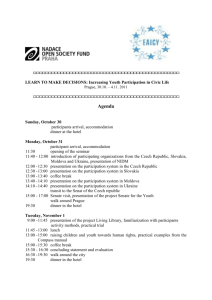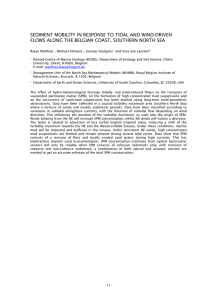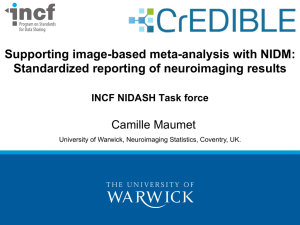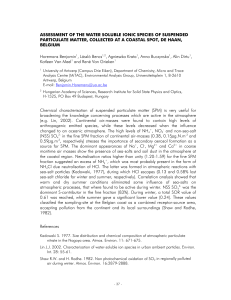Extending NI-DM to share the results and provenance of a
advertisement
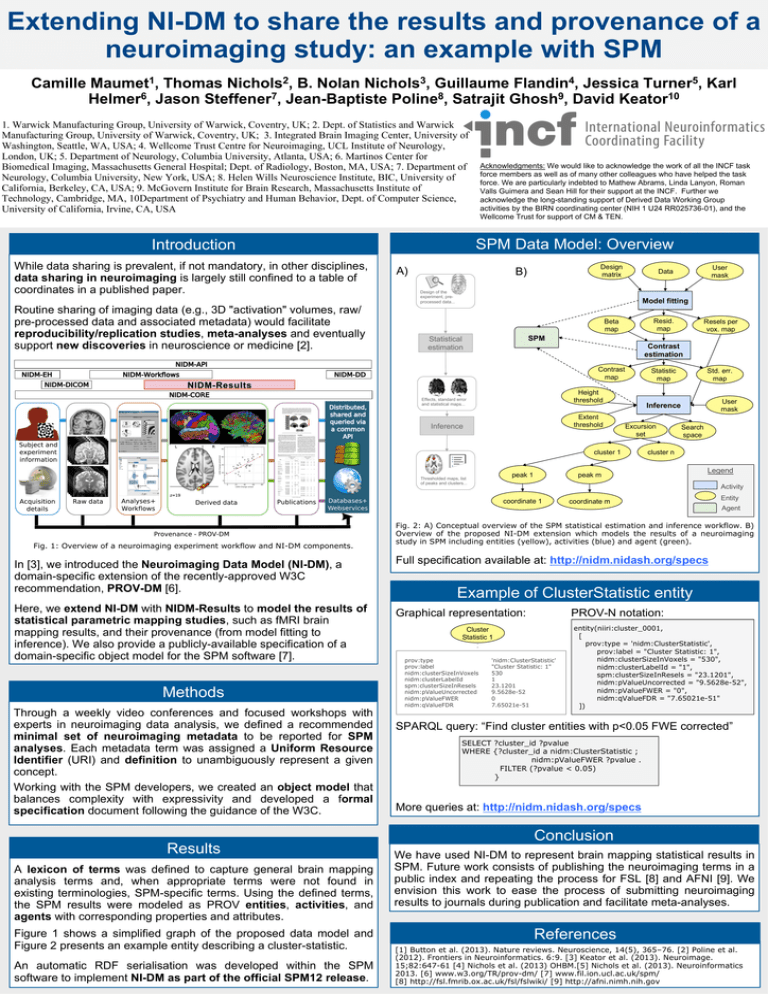
Extending NI-DM to share the results and provenance of a
neuroimaging study: an example with SPM
Camille
1
Maumet ,
2
Nichols ,
3
Nichols ,
4
Flandin ,
Thomas
B. Nolan
Guillaume
Jessica
Helmer6, Jason Steffener7, Jean-Baptiste Poline8, Satrajit Ghosh9, David Keator10
1. Warwick Manufacturing Group, University of Warwick, Coventry, UK; 2. Dept. of Statistics and Warwick
Manufacturing Group, University of Warwick, Coventry, UK; 3. Integrated Brain Imaging Center, University of
Washington, Seattle, WA, USA; 4. Wellcome Trust Centre for Neuroimaging, UCL Institute of Neurology,
London, UK; 5. Department of Neurology, Columbia University, Atlanta, USA; 6. Martinos Center for
Biomedical Imaging, Massachusetts General Hospital; Dept. of Radiology, Boston, MA, USA; 7. Department of
Neurology, Columbia University, New York, USA; 8. Helen Wills Neuroscience Institute, BIC, University of
California, Berkeley, CA, USA; 9. McGovern Institute for Brain Research, Massachusetts Institute of
Technology, Cambridge, MA, 10Department of Psychiatry and Human Behavior, Dept. of Computer Science,
University of California, Irvine, CA, USA
Routine sharing of imaging data (e.g., 3D "activation" volumes, raw/
pre-processed data and associated metadata) would facilitate
reproducibility/replication studies, meta-analyses and eventually
support new discoveries in neuroscience or medicine [2].
Acknowledgments: We would like to acknowledge the work of all the INCF task
force members as well as of many other colleagues who have helped the task
force. We are particularly indebted to Mathew Abrams, Linda Lanyon, Roman
Valls Guimera and Sean Hill for their support at the INCF. Further we
acknowledge the long-standing support of Derived Data Working Group
activities by the BIRN coordinating center (NIH 1 U24 RR025736-01), and the
Wellcome Trust for support of CM & TEN.
A)
Design
matrix
B)
User
mask
Data
Design of the
experiment, preprocessed data...
Model fitting
Resid.
map
Beta
map
Resels per
vox. map
SPM
Statistical
estimation
Contrast
estimation
Contrast
map
Statistic
map
Height
threshold
Effects, standard error
and statistical maps...
Extent
threshold
Inference
peak 1
Thresholded maps, list
of peaks and clusters...
Std. err.
map
User
mask
Inference
Excursion
set
cluster 1
Search
space
cluster n
peak m
Legend
Activity
coordinate 1
Fig. 1: Overview of a neuroimaging experiment workflow and NI-DM components.
Karl
SPM Data Model: Overview
Introduction
While data sharing is prevalent, if not mandatory, in other disciplines,
data sharing in neuroimaging is largely still confined to a table of
coordinates in a published paper.
5
Turner ,
coordinate m
In [3], we introduced the Neuroimaging Data Model (NI-DM), a
domain-specific extension of the recently-approved W3C
recommendation, PROV-DM [6].
Here, we extend NI-DM with NIDM-Results to model the results of
statistical parametric mapping studies, such as fMRI brain
mapping results, and their provenance (from model fitting to
inference). We also provide a publicly-available specification of a
domain-specific object model for the SPM software [7].
Graphical representation:
Through a weekly video conferences and focused workshops with
experts in neuroimaging data analysis, we defined a recommended
minimal set of neuroimaging metadata to be reported for SPM
analyses. Each metadata term was assigned a Uniform Resource
Identifier (URI) and definition to unambiguously represent a given
concept.
Working with the SPM developers, we created an object model that
balances complexity with expressivity and developed a formal
specification document following the guidance of the W3C.
Results
A lexicon of terms was defined to capture general brain mapping
analysis terms and, when appropriate terms were not found in
existing terminologies, SPM-specific terms. Using the defined terms,
the SPM results were modeled as PROV entities, activities, and
agents with corresponding properties and attributes.
Figure 1 shows a simplified graph of the proposed data model and
Figure 2 presents an example entity describing a cluster-statistic.
An automatic RDF serialisation was developed within the SPM
software to implement NI-DM as part of the official SPM12 release.
Agent
Fig. 2: A) Conceptual overview of the SPM statistical estimation and inference workflow. B)
Overview of the proposed NI-DM extension which models the results of a neuroimaging
study in SPM including entities (yellow), activities (blue) and agent (green).
Full specification available at: http://nidm.nidash.org/specs
Methods
Entity
Example of ClusterStatistic entity
PROV-N notation:
Cluster
Statistic 1
prov:type
prov:label
nidm:clusterSizeInVoxels
nidm:clusterLabelId
spm:clusterSizeInResels
nidm:pValueUncorrected
nidm:pValueFWER
nidm:qValueFDR
'nidm:ClusterStatistic'
"Cluster Statistic: 1"
530
1
23.1201
9.5628e-52
0
7.65021e-51
entity(niiri:cluster_0001,
[
prov:type = 'nidm:ClusterStatistic',
prov:label = "Cluster Statistic: 1",
nidm:clusterSizeInVoxels = "530",
nidm:clusterLabelId = "1",
spm:clusterSizeInResels = "23.1201",
nidm:pValueUncorrected = "9.5628e-52",
nidm:pValueFWER = "0",
nidm:qValueFDR = "7.65021e-51"
])
SPARQL query: “Find cluster entities with p<0.05 FWE corrected”
SELECT ?cluster_id ?pvalue
WHERE {?cluster_id a nidm:ClusterStatistic ;
nidm:pValueFWER ?pvalue .
FILTER (?pvalue < 0.05)
}
More queries at: http://nidm.nidash.org/specs
Conclusion
We have used NI-DM to represent brain mapping statistical results in
SPM. Future work consists of publishing the neuroimaging terms in a
public index and repeating the process for FSL [8] and AFNI [9]. We
envision this work to ease the process of submitting neuroimaging
results to journals during publication and facilitate meta-analyses.
References
[1] Button et al. (2013). Nature reviews. Neuroscience, 14(5), 365–76. [2] Poline et al.
(2012). Frontiers in Neuroinformatics. 6:9. [3] Keator et al. (2013). Neuroimage.
15;82:647-61 [4] Nichols et al. (2013) OHBM.[5] Nichols et al. (2013). Neuroinformatics
2013. [6] www.w3.org/TR/prov-dm/ [7] www.fil.ion.ucl.ac.uk/spm/
[8] http://fsl.fmrib.ox.ac.uk/fsl/fslwiki/ [9] http://afni.nimh.nih.gov
